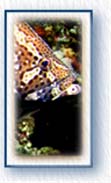








|
|
Genesis
and Management of the Reserve
Additional
Protections
Habitat
Restoration
Enforcement
Challenges
References
Fifteen to thirty miles off the east coast of Florida, a
series of submarine pinnacles and ridges extends from Ft. Pierce to Cape
Canaveral. Reaching as high as 65 feet above the sea floor, these features
act as a foundation for a habitat made distinct by the unique ivory tree
coral—Oculina varicosa. A slow-growing, delicate and branchlike
coral, ivory tree coral thickets often are associated with high
biodiversity because they provide ideal spawning sites for numerous
species, including economically important fish like several species of
grouper (gag, scamp, snowy and warsaw), black sea bass, speckled hind and
red snapper (NOAA, Ocean
Explorer, 2001).
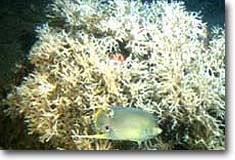 |
Healthy
Oculina coral heads, such as this one on Jeff’s
Reef within Oculina Bank, stand three to four feet high and three to
four feet across. Such habitat creates “thickets” that are used by
diverse fish and invertebrate assemblages.
|
During the 1960s and ‘70s, hook-and-line fishers
frequented Oculina Bank and landed large catches of several species of
groupers. By the early 1990s, much of the habitat was destroyed, and fish
stocks appeared to be severely depleted. The ivory tree coral that
provided reef structure needed by many resident species had been decimated
in many places—an outcome believed to be the result primarily of
destructive bottom trawling, though other causes have been implicated (NOAA, Ocean
Explorer, 2001). With the habitat in ruins, fish spawning dropped
sharply. In an effort to protect what was left and perhaps repair the
damage, scientists moved to protect the remainder of the unique Oculina
coral habitat and reestablish corals and their associated fish
population.
Genesis
and Management of the Reserve
In 1975, scientists with the
Harbor Branch Oceanographic Institution (HBOI) were conducting underwater
surveys of the continental shelf when they discovered that the high relief
pinnacles along the shelf were colonized by living, deep-water coral reefs
composed of Oculina coral. Ensuing studies investigated the distribution
of the coral, its growth rate, community structure, biological and
geological processes, and the effects of upwelling and bioerosion. Studies
also predicted the drastic decline in fish stocks and the destruction of
the coral (Reed,
2001).
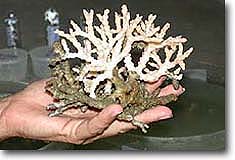 |
A small sample of ivory
tree coral, Oculina varicosa. The coral is as fragile as it
appears and is no match for heavy objects such as anchors or
trawls.
|
Bottom trawling is believed
to be the major reason for the coral’s destruction. But other factors may
account for some of the dead coral. For instance, episodic coral die-offs
or extensive bioerosion may have occurred. In addition, it is widely known
that anti-submarine patrols during World War II frequently and liberally
employed underwater explosives in their search for German U-boats off the
coast of Florida. Such activity may have adversely affected the benthic
habitat.
Regardless of the causes for damage, many scientists
believed the area needed protection. In 1980, John Reed, chief scientist
in the Division of Biomedical Marine Research at HBOI, petitioned NOAA’s
National Marine Fisheries Service (NMFS) and the South Atlantic Fishery
Management Council (SAFMC) to protect the Oculina coral habitat from
further harm. Reed, who had conducted extensive research of the habitat
and was intimately familiar with the ecology of the bank, had published
numerous articles describing the distribution and growth of the coral, and
the diverse animal communities living among it (HBOI,
2001).
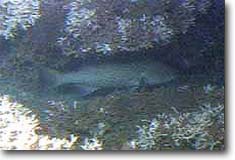 |
Gag grouper, one of the
most important commercial fish species in the southeast, taking
cover in Oculina coral. Populations of all grouper species
have been severely reduced on Oculina Bank, most likely the result
of habitat loss and overfishing.
|
In 1982, the SAFMC published
the Final Environmental Impact Statement (EIS) for Corals and Coral Reefs,
which included a proposed action to develop, adopt and implement a fishery
management plan for coral and coral reef habitats within the areas under
the authority of the SAFMC and the Gulf of Mexico Fishery Management
Council. Among other objectives, the action proposed setting aside a
portion of the Oculina Bank as a habitat of particular concern (HAPC), a
designation that would categorize it as an area of special biological
significance worthy of stricter regulatory and enforcement activity (SAFMC,
1982). In 1984, the proposed action was finalized, and NMFS set aside
92 square miles of the 300 square-mile Oculina Bank as an HAPC (HBOI, 2001).
The new designation prohibited mobile fishing gear like trawls and
dredges, but it did not affect anchoring or weights used for bottom
fishing.
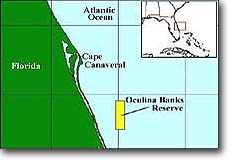 |
Approximate location of
Oculina Banks off the east coast of Florida. Here Oculina coral
"thickets" grow at depths of about 230 to 400 ft on a series of
pinnacles and ridges that extend from Ft. Pierce to Cape
Canaveral.
|
(top)
Additional
Protections
Nine years later (in
1991), damaged corals showed few signs of recovery. To encourage coral
recovery, NMFS and SAFMC proposed to establish the Oculina HAPC as an
experimental closed area—a much stricter designation. The action, which
became effective on June 27, 1994, prohibited all bottom fishing within
the newly designated Experimental Oculina Research Reserve (EORR). The
EORR was established as a 10-year experiment to determine if depleted
species, such as snapper and grouper, would rebound. The restrictions,
however, did not prohibit midwater or surface fishing from moving vessels
(SAFMC,
1993). The EORR will be eligible for reauthorization in
2004.
Just two years later, SAFMC implemented additional
protections for the EORR by prohibiting anchoring activities of fishing
vessels within the area. Fishing vessels could not drop anchors, grapples
or attached chains, which were known to damage or destroy the coral,
within the EORR (SAFMC,
1995).
By 1998, efforts were underway to amend the Oculina HAPC
even further. SAFMC was mandated by a 1996 amendment to the
Magnuson-Stevens Fishery Management Act to describe and identify essential
fish habitat (EFH), including adverse impacts on such habitat, in order to
minimize damage to EFH resulting from fishing activities. In addition, the
agency was required to identify other actions that encourage the
conservation and enhancement of EFH (Magnuson-Stevens
Act, 1996). Because Oculina Bank was considered EFH needing additional
protection, SAFMC proposed extending the boundaries of the reserve by 60
square miles to provide a larger protected area (SAFMC,
1998). The amendment included creating two protected satellite sites
of three square miles each.
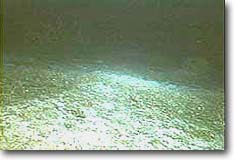 |
Oculina coral rubble. Currently, large areas of
Oculina Bank are in this condition. Note the faint outline of a reef
ball in darkness on the far right. Scientists hope that these
experimental structures will help to reestablish Oculina habitat.
|
The proposed change
met with some opposition, particularly from the longline fishing industry,
which feared that the new rule would be unduly burdensome. Some detractors
argued that the proposed expansion included large areas that did not
contain Oculina coral— only flat mud bottom habitat. Restricting these
areas would not help the coral habitat, but it would affect bottom
longline fisheries for tilefish, grouper and shark, according to the
commenters (Federal
Register, 2000).
However, NMFS reasoned that including the
non-coral habitats within the HAPC would create “buffer zones” around the
coral habitat. The buffer zones would reduce the likelihood of accidental
incursions and would simplify enforcement activities, according to NMFS.
In addition, NMFS noted that previous rules established similar zones
around areas fished by the rock shrimp and calico shrimp industries. The
agency argued that the new rule would further streamline fishing
regulations (Federal
Register, 2000).
Finally, some commenters contended that the
amendment was overly broad and exceeded the agency’s authority. NMFS,
however, believed that its legal authority under the Magnuson-Stevens Act
was broad enough to restrict activities, fishing and otherwise, that may
adversely affect EFH. Thus, in July 2000, the new rule took effect. All
gear prohibitions and anchoring restrictions that were applicable within
the old boundaries applied to the expanded boundaries and the satellite
sites as well (Federal
Register, 2000).
(top)
Habitat Restoration
Since 1995,
scientists have been trying to reestablish the fragile, slow-growing
Oculina corals by deploying concrete substrate to encourage colonization.
In 1996, they began by deploying clusters of concrete “reef balls”
throughout the reserve, hoping that the corals would attach, settle and
grow. Some were deployed with live coral already attached, and some were
deployed bare. Three years later, the scientists discovered that live
coral remained on some of the balls. On others, the coral was stripped
off, and only one reef ball deployed without coral attached showed coral
recruitment (NOAA, Ocean
Explorer, 2001).
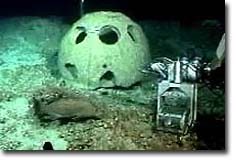 |
In September 2001, a
grouper shows interest in one of 105 reef balls a year after they
were deployed on Oculina Bank. On the right is an arm of the
submersible Clelia, used by scientists to examine progress in
this effort to reestablish Oculina habitat and the associated fish
and invertebrate
communities.
|
In 2000, a
different type of reef ball—dome-shaped equipped with holes through which
fish could swim—were deployed. The balls, which were similar in size and
shape to an Oculina coral colony, were released with live coral attached.
In the summer of 2001, explorers found that several fish species,
including groupers, amberjacks, snappers, angelfish, butterflyfish and
small basses, had colonized the structures—an encouraging sign of initial
habitat restoration. Researchers also observed more gag and scamp grouper
at the southern end of the EORR. Just 10 years ago, researchers saw no gag
grouper, fewer than 10 scamp grouper, and very few amberjacks in the same
area (NOAA,
Ocean Explorer, 2001). Though too soon to tell how successful the
coral reestablishment efforts will be, scientists are optimistic about
their initial restorative efforts (NOAA, Ocean
Explorer, 2001).
Enforcement Challenges
Because the EORR is isolated and relatively distant from
shore (17 mi), consistent enforcement of the fishing and trawling ban has
been difficult. Enforcement authorities are aware that illegal shrimp
trawling occurs in the no-fishing zone. Though spotter planes and
helicopters can survey the area, they cannot enforce the no-fishing zone
restrictions alone. If they suspect illegal activity, they must alert U.S.
Coast Guard surface vessels, which may not be available or in an
advantageous position to respond immediately. Authorities believe that
much of the illegal fishing activity occurs at night, making enforcement
more difficult. Also, aerial surveillance missions often cannot
distinguish between legal fishing activities, such as trolling for pelagic
fish, and illegal anchoring and bottom fishing. Moreover, enforcement
officers cannot determine or prove where fish were caught after a
suspected boat returns to port (Reed,
2001).
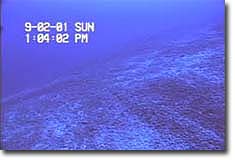 |
This image shows the likely impact of
bottom trawling on Oculina Bank. The linear mounds of coral rubble,
shown on the right, are created immediately adjacent to the track of
the trawl.
|
To aid enforcement efforts, the SAFMC recently voted
to require vessel permits and the use of vessel monitoring systems (VMS)
in the calico scallop fishery south of the Georgia-Florida border. The VMS
allows enforcement authorities to pinpoint a vessel’s position in relation
to the boundaries of the marine protected area (Reed, 2001). By
using the VMS and conducting random surveillance missions of the protected
area, as well as implementing educational efforts aimed at both commercial
and recreational fishers, SAFMC hopes that self regulation will improve
and the Oculina habitat eventually will recover.
References
Fisheries of the Caribbean, Gulf of Mexico, and South
Atlantic; Essential Fish Habitat for Species in the South Atlantic;
Amendment 4 to the Fishery Management Plan for Coral, Coral Reefs, and
Live/Hard Bottom Habitats of the South Atlantic Region (Coral FMP).
Federal Register, June 14, 2000 (65, 37292-37296). Washington, DC: U.S.
Govt. Printing Office.
Harbor Branch Oceanographic
Institution (HBOI). 2001. Harbor Branch Oceanographic Institution’s Web
site. www.hboi.edu.news/features/oculina.html.
Magnuson-Stevens Fishery Conservation and
Management Act. Public Law
94-265 (as amended through October 11,
1996). http://www.nmfs.noaa.gov/sfa/magact/
National Oceanic and Atmospheric Administration (NOAA).
2001. National Oceanic and Atmospheric Administration, Ocean Explorer Web
site.
Oceanexplorer.noaa.gov/explorations/islands01/background/
islands/sup6_oculina.html.
Reed, J. K. In press. Deep-water Oculina Coral Reefs of
Florida: Biology, Impacts and Management. Hydrobiologia. Dordrecht, The
Netherlands: Kluwer Academic Publishers.
South Atlantic Fishery Management Council (SAFMC).
1998. Amendment 4 to the Coral, Coral Reefs and Live/Hard Bottom Habitat
Fishery Management Plan. Comprehensive Amendment Addressing Essential Fish
Habitat in Fishery Management Plans of the South Atlantic
Region.
South Atlantic Fishery Management
Council (SAFMC). 1995.Amendment 3 to the Fishery Management Plan for
Coral, Coral Reefs and Live/Hard Bottom Habitats of the South Atlantic
Region.
South Atlantic Fishery Management
Council (SAFMC). 1993. Amendment 6, Regulatory Impact Review, Initial
Regulatory Flexibility Analysis and Environmental Assessment for the
Snapper Grouper Fishery of the South Atlantic Region.
South Atlantic Fishery Management Council (SAFMC).
1982. Fishery Management Plan Final Environmental Impact Statement for
Coral and Coral Reefs.
(top) |

